Video captioning
(Part 1 of 2): Win/Win for accessibility and search engine optimization (SEO)
By Holly Nielsen, Social Media Manager and Webmaster, Human Ability and Accessibility
In this two-part series, we’ll look at the exploding
growth of Internet video, and how captioning your videos can make them search
engine friendly and available to more potential customers.
Let’s face it. We’re becoming a world that documents our
every waking moment with video, and shares that video with our social networks.
Video started out as a medium that only the professionals could
afford and had the skill to use. Technology evolved – shrinking in size and
cost so that every smartphone and most cell phones now include a video camera,
and we’re all amateur videographers.
Who’s watching web videos?
Not
only are we creating video content, but we’re watching it too, all over the
world. A few examples:
- Pew Research Center reports that “More online Americans are using video-sharing sites — and they are doing so more frequently. As of May 2011, 71% of online adults reported watching videos on a video-sharing site such as YouTube or Vimeo.”
- comScore, Inc. noted in 2011 that Internet users in Germany, Turkey, Spain, and the UK watch an average of at least 30 minutes a day of online video.
- An article by Forbes about the explosion of online video in Latin America reported that in "March 2011, more than 80% of all Internet users in Brazil, Mexico, Argentina, and Chile watched online video;" in fact, 4 out of 5 users watched an average of 8 to 11 hours of online video during that month.
YouTube is the world’s largest video repository, and as of
July 10, 2012, the latest statistics
were remarkable:
- 72 hours of video are uploaded to YouTube every minute
- Over 800 million unique users visit YouTube each month
- Over 3 billion hours of video are watched each month on YouTube
- In 2011, YouTube had more than 1 trillion views or almost 140 views for every person on Earth
Businesses are embracing
video
Businesses, both business to business (B2B) and business to
consumer (B2C), have jumped on the video bandwagon, with good reason.
According to an article on Business2Community,
watching a video can have an impact on the bottom line of your business,
especially as high-level executives flock to video channels:
- According to emarketer.com, a majority of business people surveyed by Forbes in October 2010 said they watched more video currently compared to the previous year.
- Virtually 60% of respondents said they would watch video prior to reading text on the same webpage, and 22% said they generally liked watching video more than browsing text for examining business information.
- 75% of all executives said they watched work-related videos on business websites at least once a week, and more than 50% use YouTube to watch those videos.
- 65% of U.S. executives surveyed by Forbes in October 2010 visit a vendor’s website after viewing a work-related online video.
- 53% conducted a search for a vendor, product, or service for more information and 42% made a business-related purchase.
Invodo has
collected a plethora of statistics supporting how video drives conversion and
traffic for retailers, including these:
- 52% of consumers say that watching product videos makes them more confident in their online purchase decisions. When a video is information-intensive, 66% of consumers will watch the video two or more times. (Internet Retailer, 2012)
- Product videos play a key role in consumer purchase decisions, citing a 9x increase in retail video views at the start of the 2011 holiday season. (MediaPost, 2012)
- Visitors who view product videos are 85% more likely to buy than visitors who do not. (Internet Retailer, April 2010)
- Retail site visitors who view video stay two minutes longer on average and are 64% more likely to purchase than other site visitors. (Comscore, August 2010)
So now that we’ve confirmed that the use of video
as a communication medium will continue to grow, we’ll look at where
accessibility and SEO intersect when it comes to videos, part 2 of this two-part
series.



